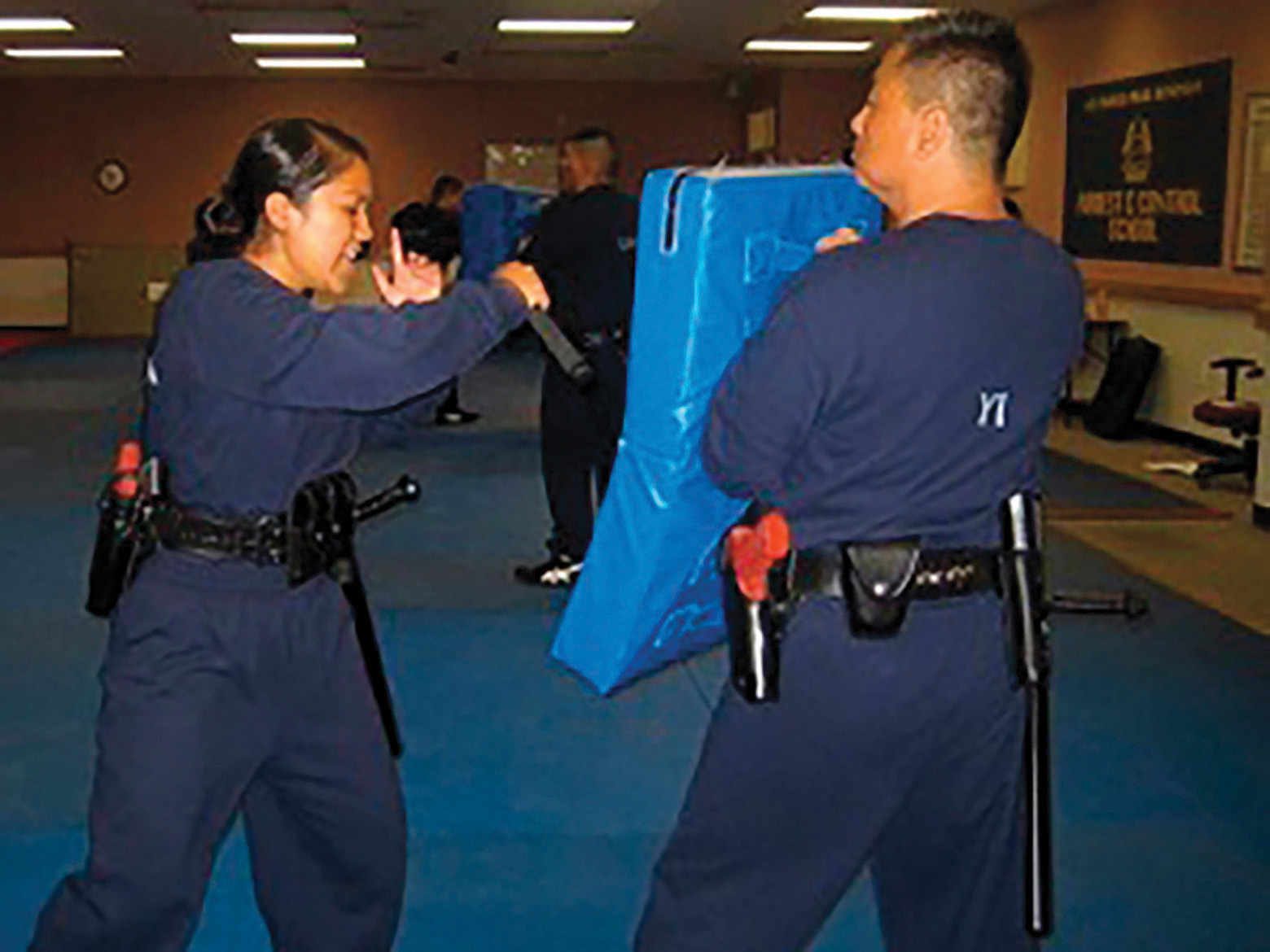
Old badges worn by LAPD reserve police officers. Today the iconic badge says “Police Officer.”
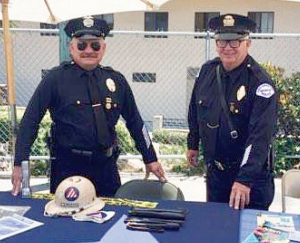
Reserve Officers Charlie Nicgorski and Mel Kennedy of the Vintage L.A. Coppers wear reserve uniforms from two different periods in history. The two officers have been researching the history of the Corps.
Editor’s note: The original version of this article appeared in the Spring 2009 issue of The Rotator. It has been updated as more information has been discovered from the past, and with added news from the last 10 years. At press time, this new article was scheduled to be printed in the 150th Anniversary LAPD Yearbook, pages of which, including this article, were edited by Karla Ahmanson.
The LAPD reserve badge evolved over the years. In 1943, diamond-shaped badges — which had been made more than 10 years prior but never used — were issued to 2,200 Corps members.1 After the program was reborn, reserve officers were issued the oval Series 6 LAPD badge that first read “Reserve Policeman” or “Reserve Policewoman,” then “Reserve Officer,” then finally just “Police Officer.” In 2007, the “R” on the badge number was removed.
Although the Reserve Corps formally became a part of the LAPD in 1947, the concept of reserves or auxiliaries started much earlier in Los Angeles, in various forms, under different names — the Los Angeles Rangers, the Home Guard, the Aero Reserve, the Police Auxiliary — all long before the official Reserve Corps came to be. Veteran Reserve Officers Mel Kennedy and Charlie Nicgorski, both members of the Vintage L.A. Coppers, have been steadfastly researching the history of the Corps. Kennedy calls these programs from long ago part of the Corps’ DNA, its ancestral lineage: “Each discovery leads to an increased understanding of our roots, drawing us into whole new areas, revealing more and more about the incredible spirit of Los Angeles and its twice-a-citizens.”
A newspaper clipping from 1914 reported on an “aerial police squad” practicing in Griffith Park. The squad consisted of four volunteer patrolmen, “being instructed by professional aviators who form an aerial police reserve.”2 Perhaps like a very early version of Air Support, if you will.
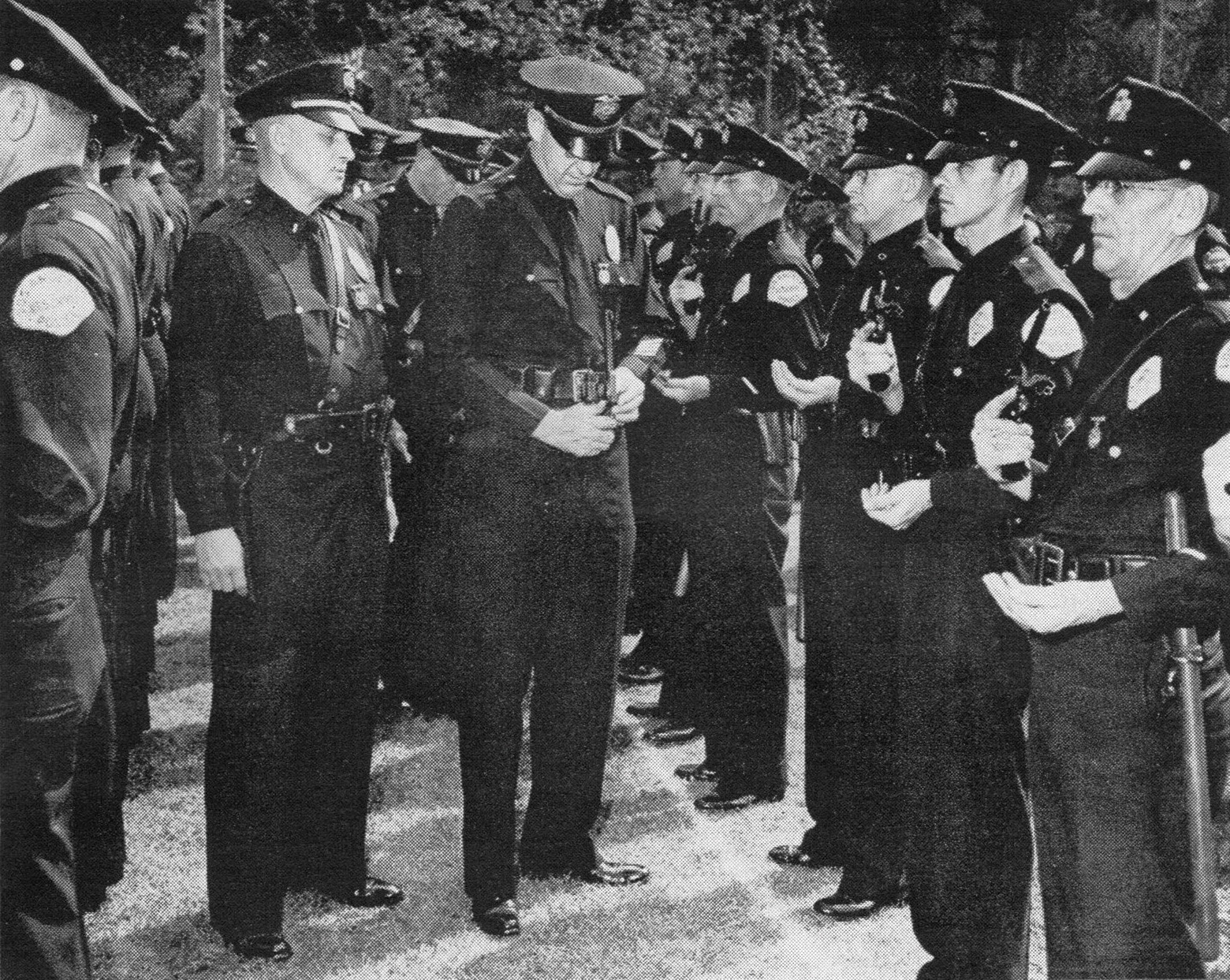
A picture from the February 1950 issue of The Beat, showing Lieutenant George S. Underhill and Deputy Chief Richard Simon at the annual reserve officer inspection at the Police Academy parade grounds

The LAPD Reserve Corps officially became a part of the Los Angeles Police Department in 1947, although there were many versions of auxiliary programs in Los Angeles prior to that.
Post-War
World War II depleted the pool of qualified police officer candidates, as many officers went off to war. To help make up for the personnel shortage, the LAPD looked to citizens, who began to serve as auxiliary police and air-raid wardens. In 2009, LAPD Reserve Police Officer Merv Asa-Dorian spoke of his father, Manoog Asadorian, who was in an auxiliary program in 1943. The family still has his ID card, signed by Chief of Police C.B. Horrall. “My brother was in school, in shop class, and they would make the mahogany batons for the auxiliaries,” Asa-Dorian remembered.
In 1944, the Los Angeles Times said, “an appropriation of $2,000 was needed to purchase police cap insignia for 2,000 Police Reserve Corps members.” There were 1,700 reserve members at the time. “In view of their voluntary service [Chief Horrall] expressed the opinion the city should at least provide the necessary emblems of authority.”3

When Reserve Officer Dennis Wong picked up his 150th anniversary badge, he said, “I never thought I’d like a star badge so much. Shiny!” LAPD officers could purchase the badge and temporarily wear it during the course of the year.
It was in 1947 that the Police Reserve Corps officially became a part of the LAPD, per a Los Angeles City Council ordinance. Recently, the historians of the Vintage Coppers came across what might be considered a holy grail of the reserve program, stored away in the files at the Los Angeles Police Museum: the original 1947 Reserve Corps Manual. Its yellowed pages revealed, for instance, that the program once had a rank structure. A “company leader” (or division commander) wore two white metal diamonds on each collar; an “alternate company leader” wore a single diamond. The manual listed the duty “limitations” at the time: “Members shall not: issue citations, serve warrants or subpoenas, [or] drive police department vehicles.” They were excluded from incidents involving labor disputes. They could not “equip their personal cars with sirens or red lights.” Yet, as we shall see, during their shifts, they faced deadly force situations and had to take care of business, as any LAPD officer would.

LAPD reserve police officer inspection during the 1950s
It was also recently discovered that in the late ’40s there was a very impactful mounted reserve corps or troop operating in the San Fernando Valley. A 1948 report said there were 40 members.4 At a time when women were afforded few opportunities in law enforcement, this mounted troop was ahead of its time, as reserve policewomen were part of a unit that was “subject to call for service in patrolling fire areas, in searches over difficult terrain, and for any major emergency,” as well as parades and large gatherings.5

The 1950s LAPD Reserve uniform worn by Paul V. Martinez, who joined the Corps in 1951, has been on exhibit at the Los Angeles Police Museum. His son Paul M. Martinez became an LAPD reserve police officer in 1983.
In 1950, the Reserve Corps was thrust into a challenging period, which nearly ended the program. In October of that year, an officer-involved shooting (OIS) gone bad during a traffic stop ignited a firestorm in the news of the day. It was said that Chief of Police William Parker was not a fan of the reserve program, and at least 200 reserve officers resigned in protest over the lack of support. One news report stated, “The mass resignation almost wiped out the West Los Angeles Station’s Reserve Corps. Eighteen reservists at Newton Station and 54 at Highland Park…”6 The roster of reserves subsequently dwindled. The program was down to only 120 by 1968. During the 1950s, the reserve program became one that primarily worked special events and details. The uniform became white caps and white shoulder patches. Kennedy noted: “The reserves that remained worked hard over the next 18 years. Chiefs of Police Thomas Redden and Edward Davis, having seen firsthand the value of the reserves over these years, put in motion a plan to revitalize the Reserve Corps, which would occur during the next decade.”
In the meantime: Several families have had a couple of generations in the Corps. Paul V. Martinez joined in 1951. His son, Reserve Officer Paul M. Martinez, remembers his father going downtown to sign up for shifts. Once, the younger Martinez recalls, his dad was assigned to work an event at the Greek Theatre — and it turned out he was the only officer assigned to work that event. “He had taken me with him,” Officer Martinez says. “He conducted traffic control and put me to work because it was a two-man operation back then. He taught me how to manually operate the traffic signal.” In 1983, Paul M. Martinez joined his father in the Corps. “We worked together a few times. We used to do these ‘Care and Share’ projects at the downtown mission, where we would provide donated clothes to needy families.” In a reminder that there is no such thing as a low-risk shift, a man pulled a knife at the event. Father and son apprehended the suspect and took him into custody. The elder Martinez retired from the Department in 1993, and his son retired in 2015. “There is so much history with these guys, a lot of which has been lost,” he says. He remembers a reserve officer who worked with his father, “Officer Flores — at the time, he was considered one of, if not the, best marksmen on the LAPD.”
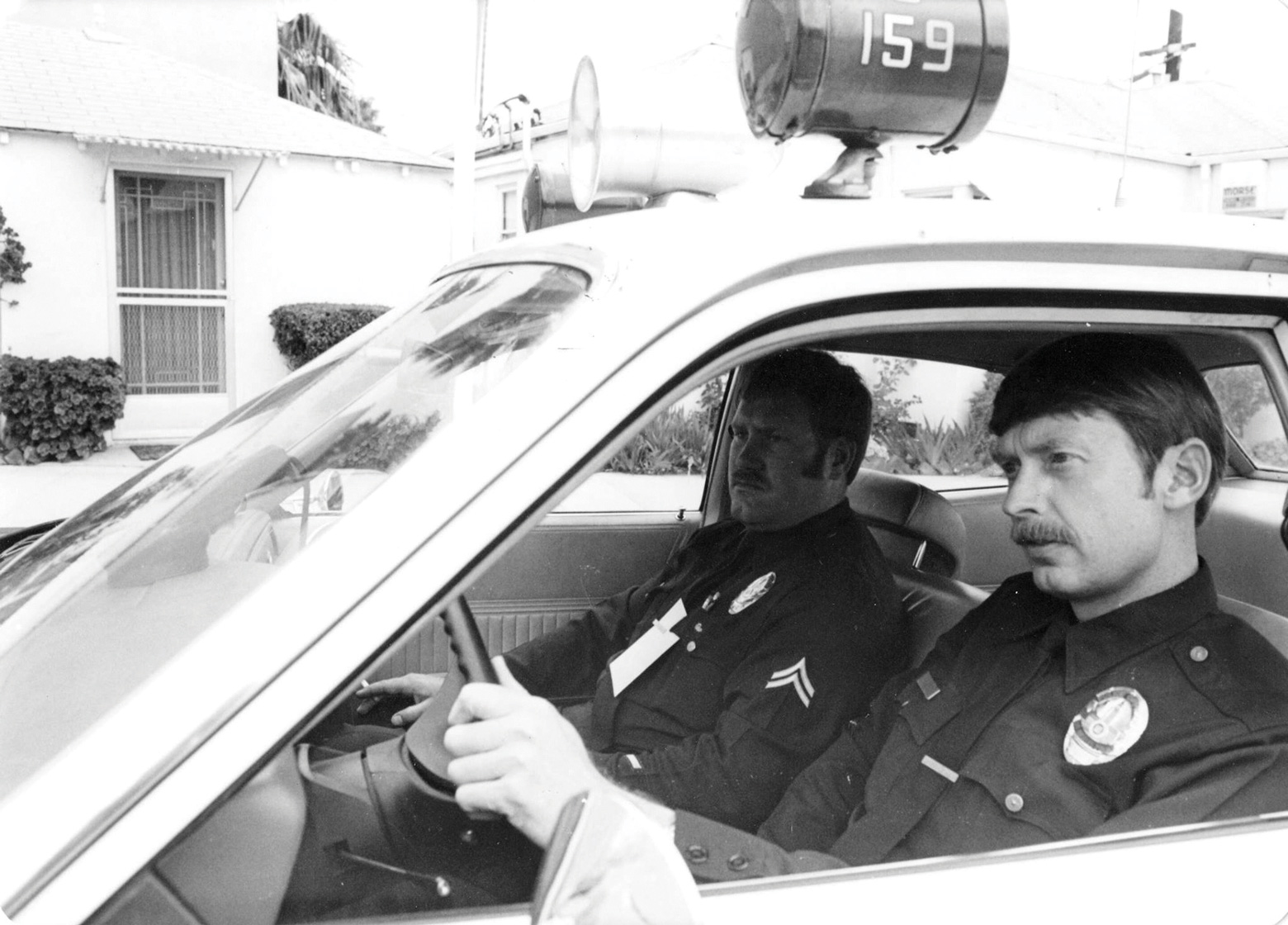
The Department’s reserve program was revamped in 1968, with the first “line reserve” class. Line reserves were to be trained as regular field officers and assigned patrol duties when they graduated. Pictured here is Reserve Officer Gary Hazel (driver), who graduated from this first class.
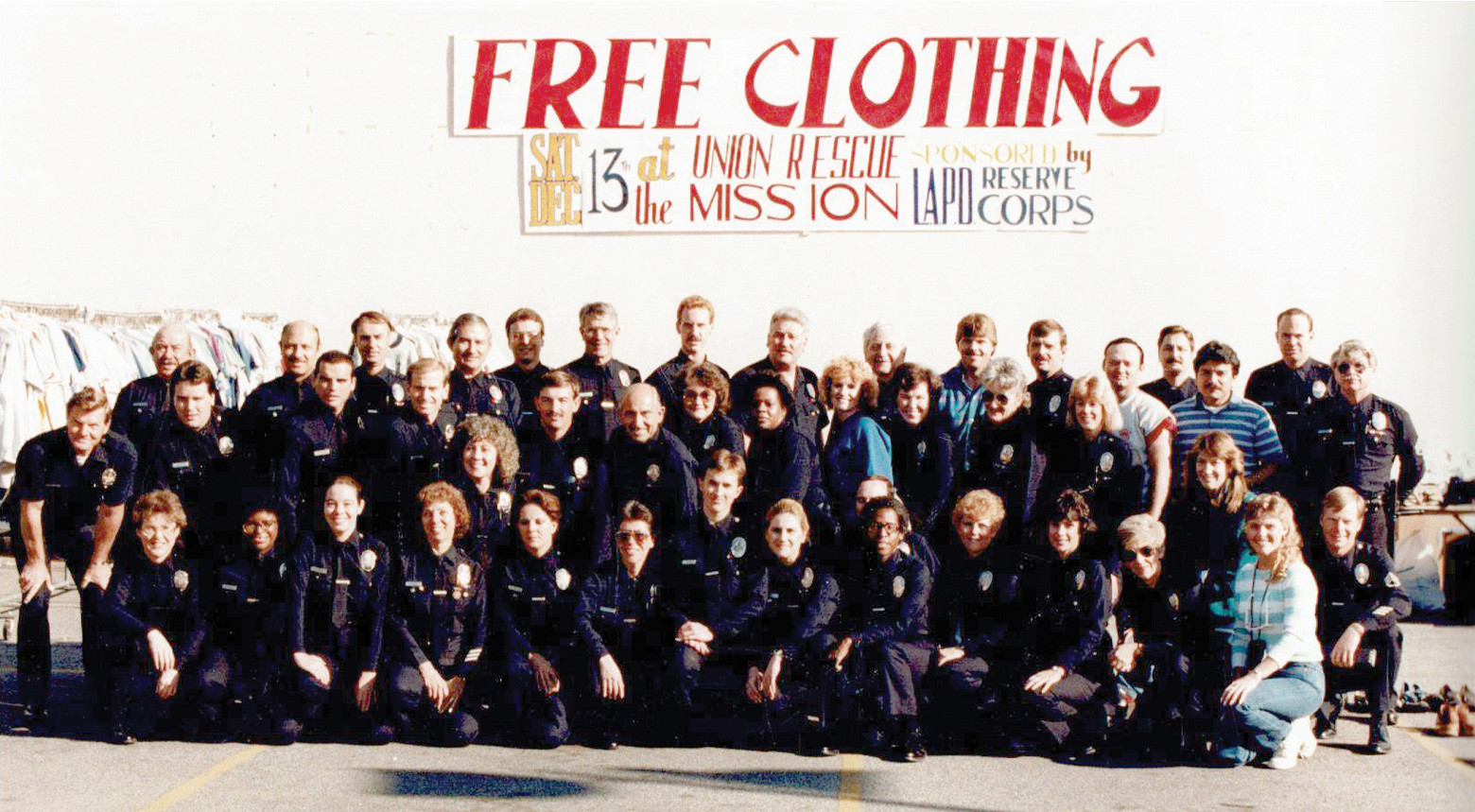
For 11 years, Sergeant Bob Kellar (pictured on far right) spearheaded the “Care and Share” program at the Los Angeles Mission with LAPD reserve police officers — providing clothing, toys, blankets, holiday music and more. The program started with 300 homeless attending and grew to over 3,300.
IN MEMORIAM
 Reserve Police Officer Stuart Tiara was killed in the line of duty as he was attempting to rescue his partners in a police helicopter crash on March 1, 1983. He was posthumously awarded the Medal of Valor and later the LAPD’s Purple Heart.
Reserve Police Officer Stuart Tiara was killed in the line of duty as he was attempting to rescue his partners in a police helicopter crash on March 1, 1983. He was posthumously awarded the Medal of Valor and later the LAPD’s Purple Heart.
There have been two known LAPD reserve police officers killed in the line of duty: Stuart Taira (Air Support Division) died in a police helicopter accident attempting to rescue his two partners on March 1, 1983. George Booker Mogle (77th Division) was shot by a prowler suspect on July 31, 1946, succumbing to his wounds a week later on August 7, 1946. In addition, “Emergency Policeman” (a position established during World War II) Norbert John Huseman was shot during a disturbance call in 1945. He died of his wounds on New Year’s Eve. He had been scheduled to lateral to full-time that January.
The 1960s and 1970s
The modern Reserve Corps developed in the 1960s. A new Mounted Unit was established at Van Nuys, which was subsequently transferred to Foothill. As retired Reserve Officer Dan Henderson described, “The unit consisted of five regulars and two reserves, Neil Stringer and Dudley Winstead. Soon the Foothill Reserve Unit had a total of 12 officers, and it even had its own oral/review board. By then, a couple of officers were working black-and-whites.” Stringer, a general contractor, would later lead the Foothill reserves in the building of the Chapel above the rock garden at the LAPD Academy.
In 1968 the program was reborn, with the LAPD’s first line reserve class. It was the year Adam-12 debuted. Chief Parker had died two years before. Jack Webb was producing the second version of the Dragnet television series, playing Sergeant Joe Friday, this time in living color. Gary Hazel entered this new Academy. Line reserves were to be trained as regular field officers and assigned patrol duties when they graduated. “We started the class at Parker Center and then moved to the Academy,” Hazel said. “We didn’t take our physicals until about a third of the way through the training because the funding wasn’t fully in place yet. We wore civilian clothes and didn’t receive our equipment until shortly before graduating.” This new line reserve class was six months long (two weeknights and every other weekend). It started with about 80 to 90 recruits and graduated about 35 officers. After he graduated, Hazel was assigned to 77th Division. On his first day, he reported to the watch commander as a new reserve police officer. The W/C looked up and said, “What the hell is a reserve officer?” Hazel found himself working the desk the first day. Later, he was assigned to a report-writing unit, as a third officer in a patrol unit, and finally he was working a regular two-officer A-unit patrol car. Hazel continued patrol — at 77th, Hollywood and Hollenbeck — for the next 35 years, until he retired in 2002.
The first reserve officer to be awarded the LAPD Medal of Valor was Ronald “Dean” Quick in May 1974. Kennedy recently found a Los Angeles Times article that reported on Quick’s heroism: “Quick (a barbershop owner) — on his first tour of duty as a policeman — dashed across traffic on the San Diego Freeway to pull a semi-conscious motorist from a burning auto.”7 The other reserves to receive the Department’s highest honor over the years: Reserve Officer Stuart Taira in 1984, Reserve Officer Michael Petrusis in 1995 and Specialist Debra Fairchild in 1999. Taira, Reserve Policeman George Booker Mogle and Emergency Policeman Norbert John Huseman later received the LAPD Purple Heart after it was established. In 2017, Reserve Officer Stephen Lee and his partner received the new Preservation of Life award.
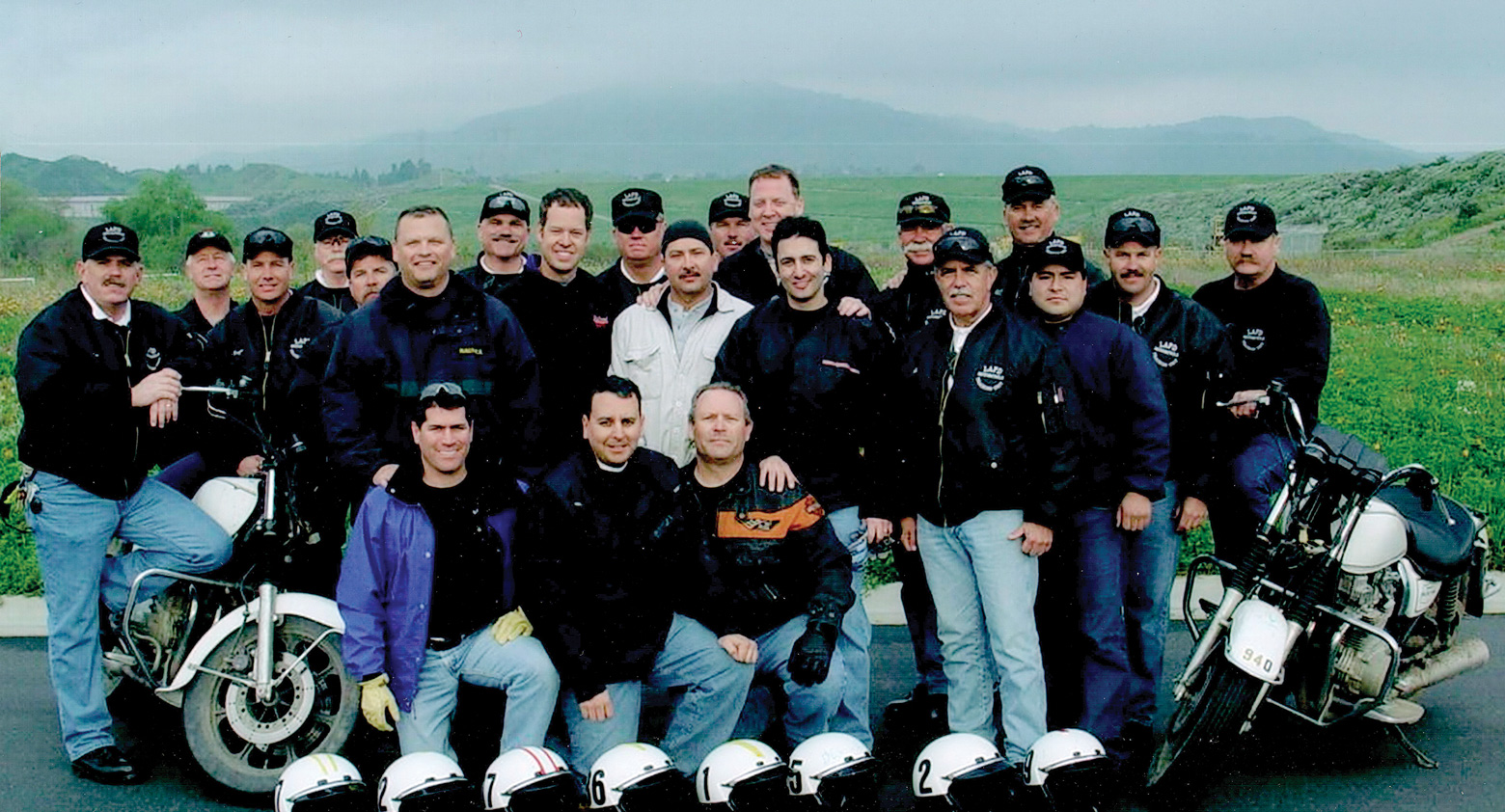
The first all-reserve Motor School was in 2005. The graduates were nicknamed the “Motor Ducks,” as class was during the rainiest months in years. Reserve Motors were assigned to West Traffic Division (WTD).
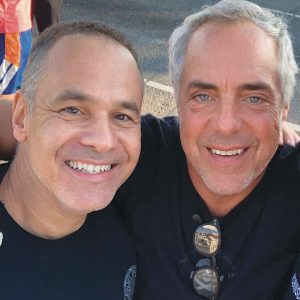
Los Angeles, the “home of the stars”: Reserve Officer Bernard Khalili (left) with Titus Welliver, star of the Amazon series Bosch, adapted from Michael Connolly’s novels about the LAPD detective. In 2018, Welliver and Connolly were honored with the Twice a Citizen award at the annual reserve banquet hosted by the Los Angeles Police Reserve Foundation.
The ’80s and a Re-Rebirth
In 1982, Sergeant Bob Kellar became the officer in charge (OIC) of the Reserve Training Unit, and he would go on to graduate 60-plus reserve officers a year for the next decade, building the Corps to some of its highest numbers in years. In 2017, the retired sergeant (who had gone on to become the mayor of Santa Clarita) was presented with the Twice a Citizen Community Leader award at the reserve banquet. The banquet journal said: “The Unit’s trailer up at Elysian Park Academy — known as the ‘head shed’ — was the center, the heart and soul of the reserve program.”
Reserve Officer Henry Baez (class 10-86R) recalls that in the mid-1980s, a pilot program at Newton was rolled out, whereby two line reserve officers would work together, first as Z-units, then chase units and, shortly thereafter, A-units. Another accomplishment during this period was the promotion of qualified reserve officers to a Certified Designated Line (currently CDL-I) status, providing expanded opportunities to work specialized details (i.e., CRASH/SPU, COBRA, Detectives, Metro, Air Support, Narcotics, Vice, Anti-Terrorism, IA) and as reserve T/Os. The LAPD implemented a Technical Reserve program, with 141 technical officers graduating in December 1980. “Technical Reserve Officers,” according to the recruitment brochure at the time, “provide support services to field personnel such as desk, community relations, detective follow-up, and related assignments.” In 1989–1990, Officer Charlie Nicgorski became the first reserve to become a Drug Recognition Expert and then a DRE instructor. The value of the Corps was further increased by the addition of “specialist officers,” a non-sworn civilian position for community members who possessed special skills and were called to duty as needed.
The Los Angeles Police Reserve Foundation was established in 1984. A 501(c)(3) nonprofit organization, the Foundation partners with the Department to support LAPD reserve officers and their families. It holds the annual Twice a Citizen/Reserve Officer of the Year banquet, which honors reserve officers and community leaders. The LAPRF helps to fund a variety of initiatives, including recruitment, equipment and training not otherwise provided by the City, scholarships and legal defense reimbursement, and Corps support for such special events as the Special Olympics and Sunshine Kids.
The Reserve Corps has continued to expand its professionalism and value throughout the Department. The requirements and standards for reserve officers of the Los Angeles Police Department have been progressively upgraded to match those of regular, full-time officers. In 2005, there was the first all-reserve Motor School. As then-Assistant Chief Michel Moore told the Los Angeles Police Commission in 2015: “I remember it well because we said, let’s start it at Davis [Training Facility], February of 2005, and someone said, what about rain? I said, not in California. And that month it was the rainiest month for six weeks that they had in like, seven or eight years.” Thus, the graduates would become known as the “Motor Ducks,” assigned to West Traffic Division.
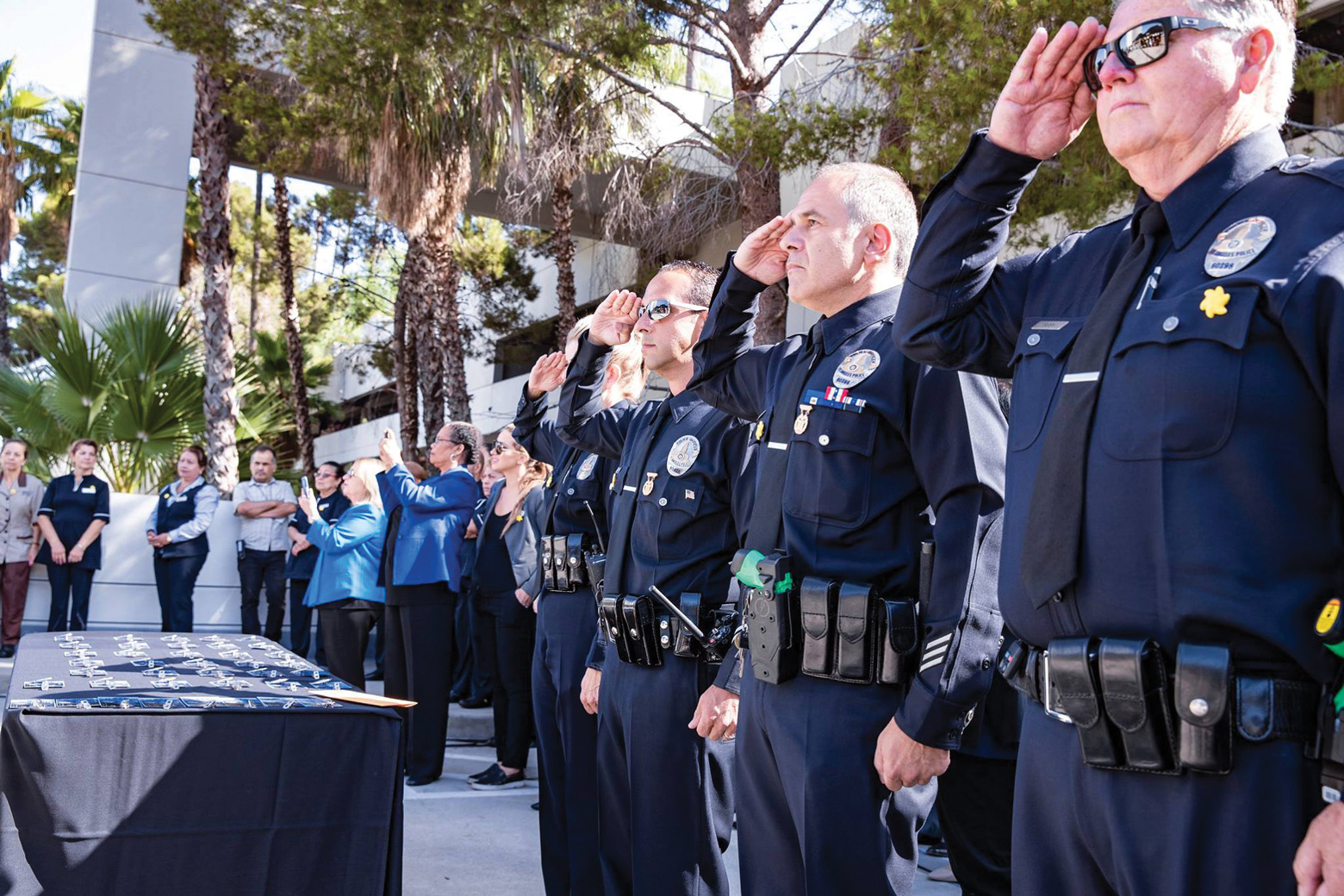
The Sunshine Kids event in 2018 with LAPD reserve officers. The Reserve Corps has, over the years, represented the Department in hosting these very special kids as they visit the City of Angels. A highlight of the event is the Code Three Run.
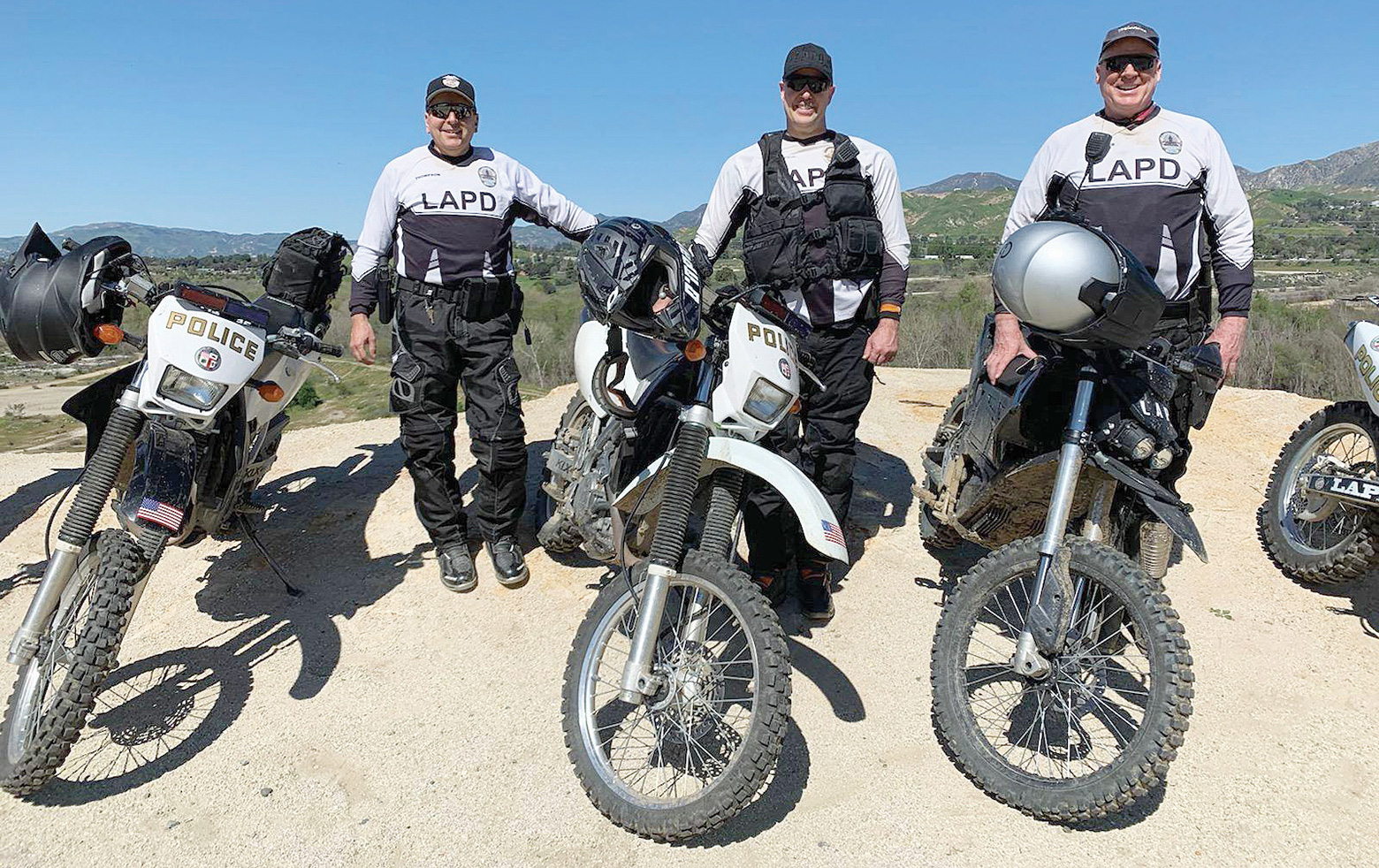
In 2019, three reserve police officers graduated from the Dual Purpose Motorcycle School, the first reserves to do so.

Specialist Reserve Lance Ordin, Air Support Division
Today
Reserve Officer Jim Lombardi, the longtime Corps R9 (the administrative leader of the Corps), says that these changes, and the growth of the Corps, necessitated legislation in Sacramento. The “Nolan Bill” was passed, which officially established three reserve officer levels in California (line officers became Level I and technical officers became Level III). “It provided for Designated and Non-Designated Level I to be deployed the same as full-time officers. The LAPD was the first large police department to designate their new reserve Academy graduates to this position (24-hour status).” A newly established Level II status provided an additional module for reserve officers to serve their community without some of the requirements of Level I.
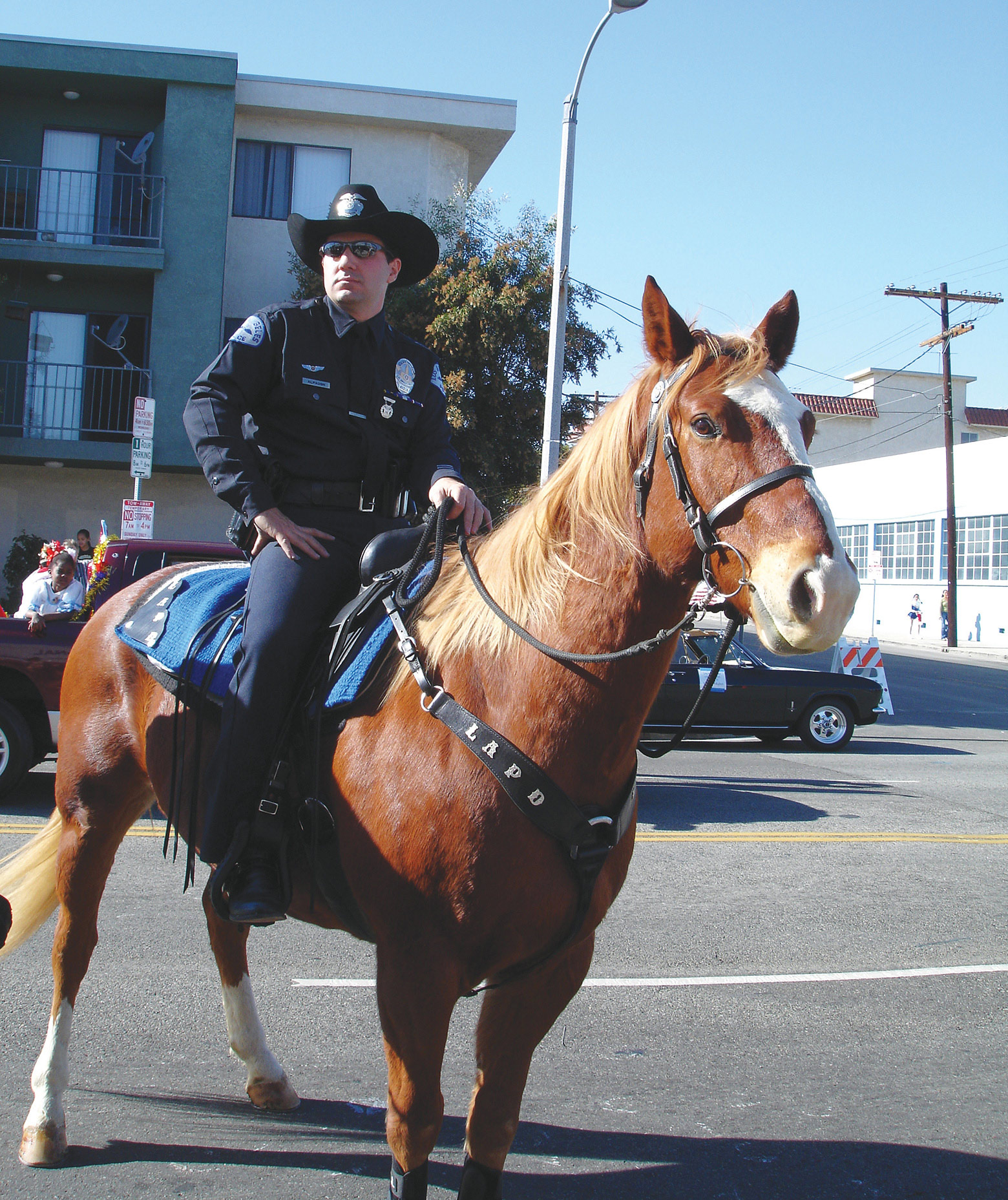
The Corps has had several mounted programs throughout the years. Pictured is current Reserve Officer J.P. Alpaugh, assigned to Metropolitan’s Mounted Unit.
Doctor Kenji Inaba, professor of surgery and vice chair of the Department of Surgery at LAC+USC Medical Center, somehow found time to go through the Academy in 2016, eventually becoming a Level I reserve officer assigned to Rampart. Chief of Police Charlie Beck subsequently established the position of chief surgeon of the LAPD and named Inaba to the position.
Chief of Police Michel Moore said later: “Kenji represents the heart and passion of both everyday Angelenos as well as the men and women of the LAPD. Our slogan for our reserve officers is ‘Twice a Citizen’ — and that’s exactly what Dr. Inaba and the rest of our reserve officers are the embodiment of.”
Today, there are about 400 reserve officers in the LAPD. They work a variety of assignments, including Patrol, Detectives, Motors and Traffic, Air Support, Mounted Unit, Counter-Terrorism and Major Crimes Division. The Reserve Corps is a vital part of the Department’s community outreach efforts, to continue building bridges with the community it protects and serves. In fact, in 2018 Chief Moore moved the reserve program to the Community Outreach and Development Division (CODD) in the Office of Special Operations under Assistant Chief Beatrice Girmala, and then to the Office of Operations under Assistant Chief Robert Arcos. Those interested in becoming Los Angeles reserve police officers can go to lapdreserve.org. The Los Angeles Police Reserve Foundation is at laprf.org.
This year, three Reserve Motors graduated from the Off-Road “Dual Purpose” Motorcycle School. LAPD HQ tweeted the pictures: “Is this what you pictured when you thought of an LAPD Reserve Officer? We recently added reserves to our Off-Road Unit, a highly-skilled group of officers who patrol the hills within Los Angeles. Spread the word — the LAPD Reserve Program is pretty cool.”
In researching the history of the Corps, Officer Nicgorski wrote: “If I were to call any period the ‘Golden Days’ of the reserves, I would say, right now [in 2019]! It’s been a 70-year struggle to get what we have today and a lot of good folks did a lot of hard work to earn the respect we have now.”
Future
The Los Angeles Police Reserve Corps and the LAPRF are trying to increase the number of viable recruits by increasing public visibility with strong marketing and word of mouth. CODD is dedicated to increasing Level I reserve status and is working diligently to swell Level III and Level II ranks as well.
The best advocates for this expansion are existing reserve officers. We should be proud of our history and accomplishments within the Department, in addition to the impact we have had on the community. Share this pride with others and set a goal to mentor someone you know through the process to become a reserve officer.
FOOTNOTES
- 1. “Civilian Defense” column, Wilmington Daily Press Journal, 12-31-1943, page 5.
- 2. “Aero Police Practice in Los Angeles Aerodrome,” The Washington Times, 8-14-1914, page 4.
- 3. Fund Asked to Buy Police Cap Insignia,” Los Angeles Times, 4-30-1944, page 16.
- 4. “For John Law” column, The Van Nuys News, 9-2-1948.
- 5. “First Troop: Mounted Police Unit Organizes, Rules for Membership Reviewed,” The Van Nuys News, 8-28-1947.
- 6. “More Police Reservists Quit in L.A.,” Wilmington Daily Press, 10-20-1950, page 1.
- 7. “Six L.A. Policemen Awarded Highest Honor: Valor Medals,” Los Angeles Times, 5-15-1974, page 3.

